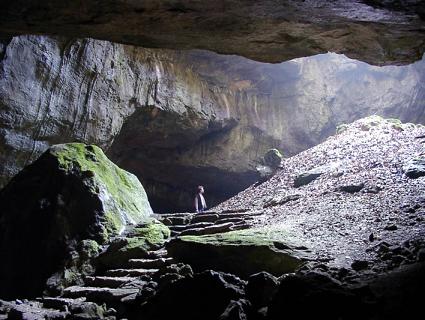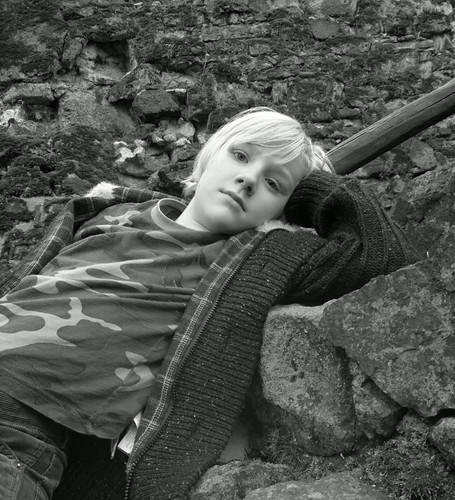
Our vacation rental apartment was fine. The best thing about it was the sauna in the basement. We bought some Deutschmarks from the landlady to use in the sauna controls. For about 1,50 Euros per night, we were sauna-ed to satisfaction. Vigo apprecaited the television. He slept on the sofa bed in the living room and got to watch cartoons on low volume until breakfast every day.
There wasn't much to explore in Bad Sachsa itself, but we spent the first couple days checking out all of the sights that were within walking distance.



The first castle ruin we hiked to was Scharzfels. This castle was built in the 10th or 11th century. Like most castles in this part of Germany, it was demolished by the French during the Seven Years War in the 18th century. The stairs up to the top of the ruin are pretty recent. Once you get up to the top, you have a great view of the area. All of the castles we visited were properly ruined for Vigo's taste. He was very disappointed last year when we visited Wartburg Castle and found it entirely intact.

Just a short walk from the castle, there is an impressive cave, called Einhornhöhle. That means Unicorn Cave. It's the biggest cave in the region, and the guided tour is well worth taking. The guide explains how the cave was formed and how it has been used by Neanderthals, Humans, cave bears, and other animals for millenia. The cave is full of bones, especially from the last ice age. One room of the cave is covered in graffiti, all written in remarkable old-fashioned print or calligraphy fonts. It used to be the done thing when visiting the cave to write your name on the wall in this room. Goethe's name is there, we were informed. Unfortunately, we aren't allowed to take photos inside the cave, so the only photo I can show is one I found on the website of a vacation rental.

Gottfried Wilhelm Leibniz is responsible for the cave's name. Apparently a better mathematician than biologist, he believed that they had discovered unicorn bones in the cave. The unicorn skeleton which convinced Leibniz had long front legs and a small wheel at the end of its spine. Yes, a small wheel. It had been reconstructed by the mayor of Magdeburg from various prehistoric mammal bones, plus a narwhale tooth.

Leibniz, who was a pretty good businessman, made this cave famous for its unicorn bones and supplemented his mining income selling various tinctures of unicorn-bone powder all over Europe.
The next day we went to explore the dwarf caves and another little ruin Vigo had spotted on our hiking map.
The brick work in the remains of this old tower was pretty interesting.

The dwarf caves are pretty cool. They are just big enough for Vigo to sit up inside.


After a few days of hiking around and exploring the nearby villages and sights, Erik took a train to the next slightly larger town and rented us this car. Those of you who know Erik well will be aware of the fact that Erik hates to look like a tourist. This car blew his cover, though I'm pretty sure every single person in Bad Sachsa personally knows every other person in the town by name, so we weren't fooling anyone.

We took this ambulant advertisement to visit a farther-off ruin which Vigo had found out about on the internet before going on vacation. Burg Hohnstein has a lot of its walls still standing, and much of it has been reconstructed or repaired. You really get a sense here of how uncomfortable and unpleasant it must have been staying there. These are military fortresses, not luxurious palaces.

Vigo and I did a photo series there pretending to be various medieval caslte charcters.
The Thief


The Knight


The Prince/Princess


The Peasant


This castle also had a great view, of course. You can see in this picture that we had pretty iffy weather. It was raining on and off for the whole trip.

The next day, we visited Kyffhäuserdenkmal and the castle ruins it was built upon. This impressive monument was built in honor of Kaiser Wilhelm to express the opinion of Prussians that Wilhelm was the legitimate successor to the German empire, in direct (spiritual) lineage with the medieval king Barbarossa. The whole affair is basically a bombastic love poem to Germany's military strength. Here you see Barbarossa slouching at the base of the monument. This was my favorite part of the sculpture. He looks like some slovenly Greek god, and there is a nice little chasm of raw stones preventing you from getting too close.

The monument was on the Soviet side during the DDR times. The Soviets famously decided not to touch this site, stating that the Germans must learn to live with their history and their monuments.
The monument is connected to two castle ruins. One of them boasts the deepest castle well in the world. The tourist attraction connected to this well is a machine where you can buy Barbarossa's gall stones in order to wake the ghost of the well. You have to roll the precisely-sized stone through a special hole in the well cover. As it falls, it triggers a recording of the ghost. There are three or four sad, comical statements which play in rotation.


On a lot of the tourist sites we visited, we saw signs warning us that we were in mortal danger if we failed to follow posted rules. Vigo and I found these signs kind of hilarious in their overstatement.

I am going to guess that you are starting to be as bored of castle ruins now as I was by the time we got to this place, so I'll just post the pictures of the view and the half-standing walls without further comment.






My favorite part of the vacation came on our last day, when we drove to Shierke and took the narrow-gauge railway up to the top of the highest mountain in the region, the Brocken. The Harzquerbahn has been running since 1897. It was fun standing on the back deck of the old train car, listening to the sound of the machine on the track. When we got to the top of the mountain, it was cold and foggy.



After the train ride, we had enough time to visit one of the other major caves. Baumann's Cave has a theater inside, named after Goethe, where you could see a performance of Little Red Riding Hood, if you were so inclined.

The best thing about the cave are the stalagmites and stalagtites. This cave has been a tourist attraction since the 1500s, so it's got orderly paths and lots of fancy lighting. I felt a little twinge of sadness thinking of all the stalagmites they cleared away to put in those stairs and walkways.
As with the other big cave, no photos were allowed. Interestingly, the guide at Baumann's also claimed that the cave was the largest in the region. Probably depends how you measure it.
Here's a postcard I found online.

We caught our train home on Sunday, the last day before the new school year started.
If you want to see all of the photos from this vacation, you will find them here
nice!
ReplyDelete